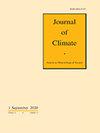没有证据表明欧亚大陆在上个千年发生大规模低纬度火山爆发后冬季变暖
IF 4
2区 地球科学
Q1 METEOROLOGY & ATMOSPHERIC SCIENCES
引用次数: 0
摘要
摘要 最近的建模研究表明,即使是公元纪最大的火山喷发,内部变率也可能压倒任何被迫的火山反应,有鉴于此,我们重新严格审查了火山喷发是否会导致欧亚大陆冬季地表变暖的问题。我们将重点放在上个千年,结合模型输出、仪器观测、树环记录和冰芯,建立了专门针对北方冬季的新的温度重建。我们重点研究了最近千年中 20 次火山喷发,其平流层硫注入量(VSSI)大于 1991 年皮纳图博火山喷发。我们发现,在这 20 次大型喷发事件中,只有 7 次在喷发后的第一个冬季欧亚大陆上空出现了温暖的地表温度异常。在研究 13 个出现爆发后低温异常的事件时,我们发现冬季降温的幅度与 VSSI 质量之间没有相关性。我们也没有发现北大西洋涛动与冬季 VSSI 相关的证据,而 VSSI 是低纬度大喷发可能导致欧亚大陆冬季变暖的机制中的一个关键因素。此外,通过对单次火山爆发的研究,而不是将火山爆发事件合并到一个叠加的年代分析中,我们能够将我们的研究结果与之前的研究结果相协调。对另外两个古气候数据集的分析证实了火山爆发后欧亚大陆冬季没有变暖。我们的研究结果涵盖了整个上个千年,证实了最近大多数建模研究的结果,并提供了重要的新证据,证明大型低纬度火山爆发后,欧亚大陆冬季地表一般不会明显变暖。本文章由计算机程序翻译,如有差异,请以英文原文为准。
No evidence of winter warming in Eurasia following large, low-latitude volcanic eruptions during the Last Millennium
Abstract We critically reexamine the question of whether volcanic eruptions cause surface warming over Eurasia in winter, in the light of recent modeling studies that have suggested internal variability may overwhelm any forced volcanic response, even for the very largest eruptions during the Common Era. Focusing on the Last Millennium, we combine model output, instrumental observations, tree-ring records, and ice cores to build a new temperature reconstruction that specifically targets the boreal winter season. We focus on 20 eruptions over the Last Millennium with volcanic stratospheric sulfur injections (VSSI) larger than the 1991 Pinatubo eruption. We find that only 7 of these 20 large events are followed by warm surface temperature anomalies over Eurasia in the first post-eruption winter. Examining the 13 events that show cold post-eruption anomalies we find no correlation between the amplitude of winter cooling and VSSI mass. We also find no evidence that the North Atlantic Oscillation is correlated with VSSI in winter, a key element of the proposed mechanism through which large low-latitude eruptions might cause winter warming over Eurasia. Furthermore, by inspecting individual eruptions rather than combining events into a superposed epoch analysis, we are able to reconcile our findings with those of previous studies. Analysis of two additional paleoclimatic datasets corroborates the lack of post-eruption Eurasian winter warming. Our findings, covering the entire Last Millennium, confirm the findings of most recent modeling studies, and offer important new evidence that large low-latitude eruptions are not, in general, followed by significant surface wintertime warming over Eurasia.
求助全文
通过发布文献求助,成功后即可免费获取论文全文。
去求助
来源期刊

Journal of Climate
地学-气象与大气科学
CiteScore
9.30
自引率
14.30%
发文量
490
审稿时长
7.5 months
期刊介绍:
The Journal of Climate (JCLI) (ISSN: 0894-8755; eISSN: 1520-0442) publishes research that advances basic understanding of the dynamics and physics of the climate system on large spatial scales, including variability of the atmosphere, oceans, land surface, and cryosphere; past, present, and projected future changes in the climate system; and climate simulation and prediction.
 求助内容:
求助内容: 应助结果提醒方式:
应助结果提醒方式:


